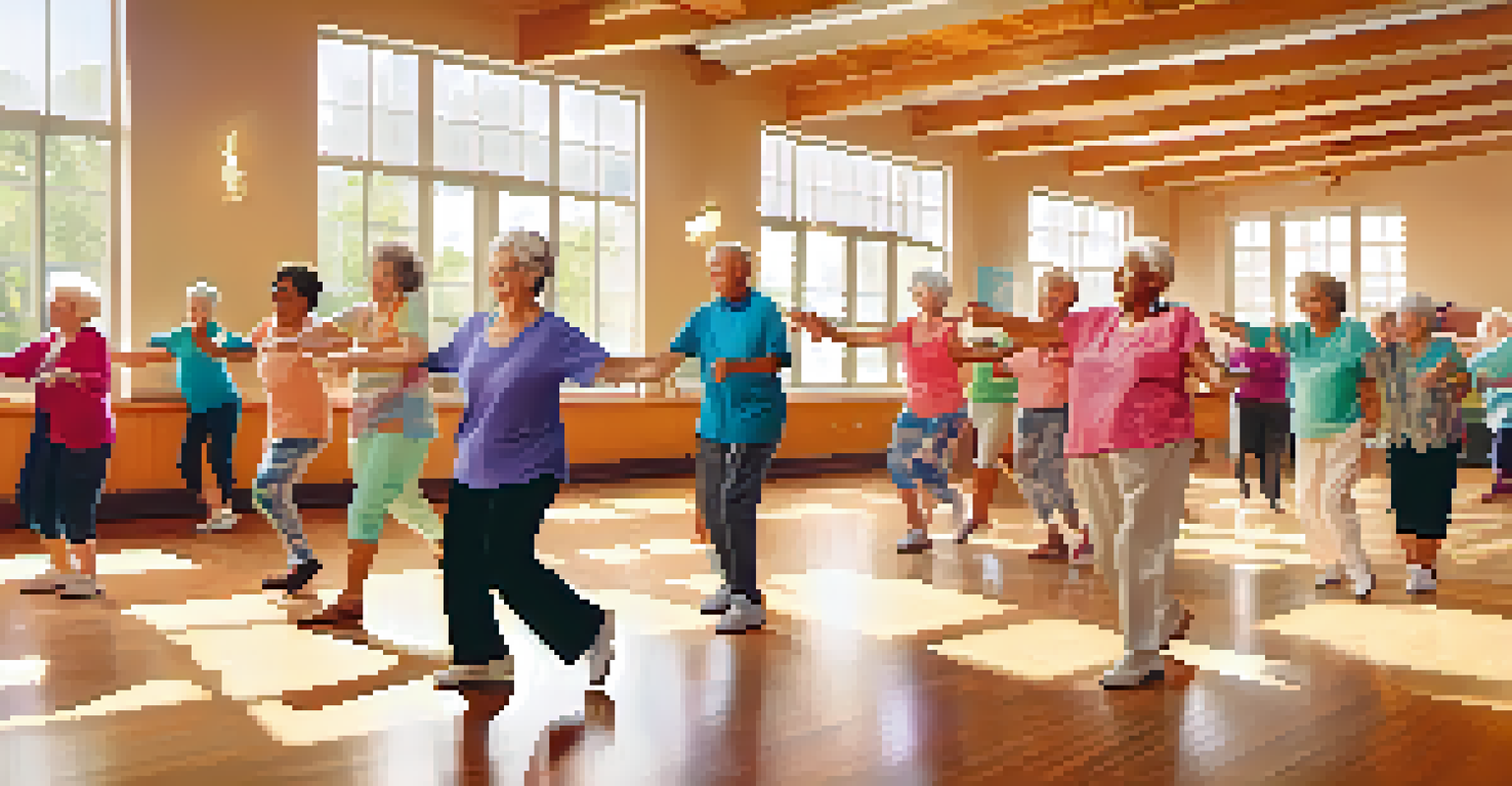Dance and Aging: Effects on Cognitive Decline and Memory

Understanding Cognitive Decline and Aging
As we age, many of us experience cognitive decline, which can affect memory, attention, and decision-making. This natural process varies from person to person, but it often leads to challenges in daily life, making activities like remembering names or following conversations more difficult. It's essential to recognize that while aging is inevitable, the extent and impact of cognitive decline can be influenced by various factors, including lifestyle choices.
Dance is the hidden language of the soul.
Research has shown that engaging in mentally stimulating activities can help combat these changes. Dance, in particular, stands out as a unique blend of physical movement and cognitive engagement. When we dance, we not only move our bodies but also engage our brains in ways that challenge our coordination, memory, and even social skills.
Moreover, understanding cognitive decline is crucial for finding effective interventions. By recognizing the symptoms and how they manifest, we can better appreciate the potential role of activities like dance in maintaining cognitive health as we age. This sets the stage for exploring how dance specifically can contribute to cognitive vitality.
The Cognitive Benefits of Dance for the Elderly
Dance is not just a fun way to express oneself; it has profound cognitive benefits, especially for older adults. Engaging in dance can stimulate brain functions, enhance memory, and even improve problem-solving skills. For instance, learning new dance steps or routines requires concentration and the ability to recall movements, which exercises the brain in a unique way.

A study showed that seniors who participated in regular dance classes performed better on cognitive tests than those who did not. The challenge of learning choreography engages multiple areas of the brain, promoting neuroplasticity—the brain's ability to adapt and form new connections. This is particularly vital as we age since it can help mitigate the effects of cognitive decline.
Dance Enhances Cognitive Health
Engaging in dance stimulates brain functions, improves memory, and promotes neuroplasticity in older adults.
Additionally, dance often involves social interaction, which is another critical component of cognitive health. When we dance with others, we not only share a joyful experience but also stimulate our minds through conversation and connection. This social aspect can be just as beneficial as the physical activity itself, creating a holistic approach to maintaining cognitive function.
Dance as a Social Activity for Older Adults
Social interaction is vital for mental health, especially as we age. Dance classes provide an excellent opportunity for older adults to connect with peers, fostering friendships and a sense of community. This social engagement can combat feelings of loneliness and isolation, which are common among the elderly and can adversely affect cognitive health.
The body says what words cannot.
Moreover, participating in group dance activities encourages collaboration and communication, further enhancing cognitive function. When older adults share their dance experiences or partner with others, they engage in conversations that stimulate their brains. This interaction can lead to improved mood and mental sharpness, creating a positive feedback loop.
Consider a local dance class where participants not only learn moves but also share stories and laughter. These interactions can create lasting bonds and provide emotional support, both of which are crucial for maintaining cognitive vitality. By dancing together, older adults can enjoy physical benefits while enriching their social lives.
How Dance Combats Cognitive Decline
The connection between dance and cognitive function lies in the multi-faceted engagement dance offers. When we dance, we use rhythm, memory, and spatial awareness, all of which engage different parts of the brain. This variety keeps the brain active and challenged, which is essential for staving off cognitive decline.
Dance also encourages physical fitness, which is closely linked to cognitive health. Regular movement increases blood flow to the brain and promotes the release of beneficial hormones that support brain health. Think of it as a workout for both the body and the mind, where each step taken is a step toward better cognitive function.
Social Connection Through Dance
Participating in dance classes fosters friendships and combats loneliness, which positively impacts mental health.
Furthermore, the joy and creativity involved in dance can reduce stress and anxiety levels, which can negatively impact cognition. By creating a joyful experience, dance not only boosts mood but also enhances overall mental well-being. This holistic approach makes dance a powerful tool in the fight against cognitive decline.
Types of Dance Beneficial for Cognitive Health
Not all dances are created equal when it comes to cognitive benefits. Styles that require memorization and coordination, such as ballroom, salsa, or swing dance, are particularly effective. These dances often involve learning new steps and routines, which keeps the brain engaged and sharp.
Moreover, improvisational dance forms, like contemporary or freestyle, encourage creativity and self-expression. This can stimulate cognitive function by allowing dancers to explore movement in unique ways, fostering brain flexibility. By mixing different styles, older adults can enjoy a well-rounded approach that keeps their minds active.
Consider joining a local dance group that offers various styles. Not only will this provide physical activity, but it will also keep the brain engaged through diverse challenges. The key is to find something enjoyable; after all, the more fun we have, the more likely we are to stick with it!
Real-Life Examples of Dance Impacting Aging
Many communities have discovered the value of dance programs for older adults, showcasing real-life success stories. For instance, a retirement community introduced weekly dance classes, and participants reported improved mood and mental clarity. These stories highlight the tangible benefits of dance, both cognitively and socially.
One participant, who initially struggled with memory issues, found great joy and improvement through dance. This individual not only enhanced their cognitive abilities but also formed lasting friendships that enriched their life. Such anecdotes illustrate how dance can transform lives beyond just physical fitness.
Accessible Dance for All Ages
Starting a dance journey is easy and beneficial, offering cognitive and physical advantages regardless of experience.
These examples serve as inspiration for others who may be hesitant to try dance. The benefits are clear: dance isn't just movement; it's a pathway to improved cognitive health, social connections, and a brighter outlook on aging. By sharing these stories, we can encourage more older adults to embrace dance.
Getting Started with Dance at Any Age
Starting a dance journey can seem daunting, especially for those who feel out of practice. However, the beauty of dance is that it's accessible to everyone, regardless of experience or ability. Simple steps, such as joining a local dance class or even dancing at home, can set the stage for cognitive benefits.
Consider exploring different dance styles to find what resonates with you. Whether it's line dancing, Zumba, or ballroom, the key is to enjoy the process. Engaging with dance in a way that feels comfortable can spark motivation and excitement, encouraging a consistent practice.

Remember, it's never too late to start dancing! Embrace the rhythm, let go of inhibitions, and enjoy the myriad of benefits that come with moving to the music. The journey of dance can be a joyful exploration of both body and mind, enhancing life at any age.